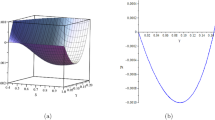Abstract
Intermediate mass black holes may be formed through repeated coalescences of compact objects or through the direct collapse of a hypermassive star formed through runaway collisions of main sequence stars. The gravitational wave signature of these two formation scenarios will be different. Here we present an initial study of the waveform generated during the direct axisymmetric collapse of a hypermassive star in order to facilitate searches for this source. We approximate the collapse of the core as an axisymmetric Newtonian free-fall of a rotating relativistic degenerate iron core. The collapse waveform can be reasonably well modeled by an exponential growth.
Similar content being viewed by others
References
Ott C.: The gravitational-wave signature of core-collapse supernovae. CQG 26, 063001 (2009)
Portegies Zwart S.F., McMillan S.L.W.: The runaway growth of intermediate-mass black holes in dense star clusters. ApJ 576, 899 (2002)
Soria, R.: Runaway core collapse and cluster survival: where are the parent clusters of ULXs? In: Chen P., Bloom E., Madejski G., Patrosian V.(eds) Proceedings of the XXII Texas symposium on relativistic astrophysics at Stanford University, eConf. C041213 (2004)
Freitag M., Rasio F.A., Baumgart H.: Runaway collisions in young star clusters: I. Methods and tests. MNRAS 368, 121 (2006)
Freitag M., Gurkan M.A., Rasio F.A.: Runaway collisions in young star clusters: II. Numerical results. MNRAS 368, 141 (2006)
Suzuki T.K., Nakasato N., Baumgardt H., Ibukiyama A., Makino J., Ebisuzaki T.: Evolution of collisionally merged massive stars. ApJ 668, 435 (2007)
Yungelson L.R., van den Heuvel E.P.J., Vink J.S., Portegies Zwart S.F., de Koter A.: On the evolution and fate of super-massive stars. Astron. Astrophys. 477, 223 (2008)
Saenz R.A., Shapiro S.L.: Gravitational radiation from stellar collapse: ellipsoidal models. ApJ 221, 286 (1978)
Saenz R.A., Shapiro S.L.: Gravitational and neutrino radiation from stellar core collapse: improved ellipsoidal model calculations. ApJ 229, 1107 (1979)
Detweiler S., Lindblom L.: On the evolution of the homogeneous ellipsoidal figures. II. Gravitational collapse and gravitational radiation. ApJ 250, 739 (1981)
Goggin L.M.: A search for gravitaional waves from perturbed black hole ringdowns in LIGO data. California Institude of Technology, USA (2007)
Abbot B. et al.: Search for gravitational wave ringdowns from perturbed black holes in LIGO S4 data. PRD 80, 062001 (2009)
Binney J., Tremaine S.: Galactic dynamics, Princeton series in Astrophsics princeton. Princeton University Press, New Jersey (1987)
Zel’dovich Ya.B., Novikov I.D.: Relativistic Astrophysics, Vol 1: Stars and Relativity. University of Chicago Press, Chicago (1971)
Shapiro S.L., Teukolsky S.A.: Black holes, white dwarfs, and neutron stars. Wiley, New York (1983)
Padmanabhan T.: Theoretical astrophysics, Vol @: stars and stellar systems. Cambridge University Press, Cambridge (2001)
Carroll B.W., Ostlie D.A.: An Introduction to Modern Astrophysics, 2nd edn. Pearson/Addison Wesley, San Francisco (2007)
Author information
Authors and Affiliations
Corresponding author
Rights and permissions
About this article
Cite this article
Li, J., Benacquista, M. Phenomenological gravitational radiation from rotating stellar collapse to an intermediate mass Kerr black hole. Gen Relativ Gravit 42, 2511–2523 (2010). https://doi.org/10.1007/s10714-010-1001-9
Received:
Accepted:
Published:
Issue Date:
DOI: https://doi.org/10.1007/s10714-010-1001-9



